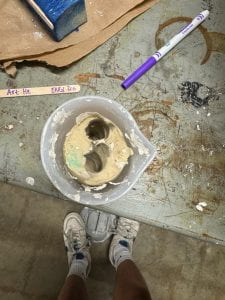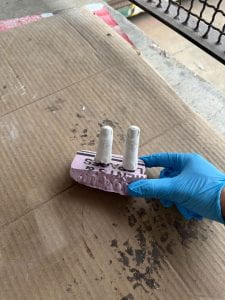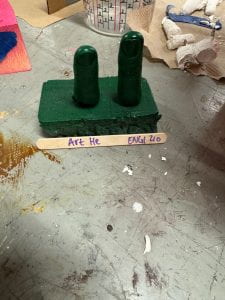For my molding and casting homework, I started the process in class by first mixing together a 1:1 ratio of water and alginate in a small silicone container. After using a popsicle stick and mixing the combination together until it looked like pancake batter, I stuck my two fingers in the mixture and tried to stay as still as possible. I wanted to make sure there was enough space on the sides and bottom of the piece so that the molds would come out well. After waiting about 10 minutes, I took my fingers out and taped together a popsicle stick and 2 screws so that the fingers could be inserted into a wall. I made a 2:1 plaster to water mixture and poured it in the mold and let it sit for a few hours.

Figure 1: Finger Mold
After taking my fingers out the mold, I stuck them in a piece of foam so that it would be easier to stand up and spray paint.

Figure 2: Mold of 2 Fingers
I then post-processed the fingers by adding 2 coats of green spray paint and one coat of clear coat to protect the paint. Overall this was a very cool homework and was awesome being able to learn something new!

Figure 3: Final Finger Molds
Cost Breakdown:
Alginate ($54.97/3 lb), about 70g was used so $2.82
Plaster ($17.99/5 lb), about 200 grams was used so $1.58
Spray Paint ($4.64/12 oz), about 0.5 oz was used so $0.19
Clear Coat ($6.48/12 oz), about 0.25 oz was used so $0.14
Labor ($15/hour) * 1 hour = $15
Total: $19.73
Clean Workspace:

Figure 4: Clean Workspace
